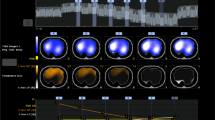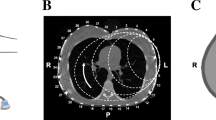Conclusion
EIT is a new, portable imaging technique which is increasingly being considered as a future tool for evaluation of the immediate effects of a change in ventilation or other therapeutic intervention in critically ill patients. The method is suitable for monitoring regional lung function directly at the bedside. Steady advances in the development of EIT technology over the past 20 years makes a routine application in a clinical setting in the next decade possible. Nevertheless, further development of both EIT hardware and software is necessary to increase the quality of data, user-friendliness, and clinical acceptance. Proof of clinical efficiency has to be provided. Results of several studies indicate that EIT might be of benefit in optimizing ventilator therapy and minimizing the incidence of ventilator-associated lung injury but this has to be proven in larger clinical studies.
Access this chapter
Tax calculation will be finalised at checkout
Purchases are for personal use only
Preview
Unable to display preview. Download preview PDF.
Similar content being viewed by others
References
Barber D, Brown B (1984) Applied potential tomography. J Phys E Sci Instrum 17:723–733
Brown BH, Barber DC, Seagar AD (1985) Applied potential tomography: possible clinical applications. Clin Phys Physiol Meas 6:109–121
Kotre CJ (1997) Electrical impedance tomography. Br J Radiol 70:S200–205
Holder DS, Brown BH (1994) Biomedical applications of EIT: a critical review. In: Holder DS (ed) Clinical and Physiological Applications of Electrical Impedance Tomography, UCL press, London, pp 6–40
Frerichs I (2000) Electrical impedance tomography (EIT) in applications related to lung and ventilation: a review of experimental and clinical activities. Physiol Meas 21:R1–21
Arnold JH (2004) Electrical impedance tomography: on the path to the Holy Grail. Crit Care Med 32:894–895
Hedenstierna G (2004) Using electric impedance tomography to assess regional ventilation at the bedside. Am J Respir Crit Care Med 169:777–778
Geddes LA, Baker LE (1967) The specific resistance of biological material — a compendium of data for the biomedical engineer and physiologist. Med Biol Eng 5:271–293
Boone K, Barber D, Brown B (1997) Imaging with electricity: report of the European Concerted Action on Impedance Tomography. J Med Eng Technol 21:201–232
Hahn G, Sipinkova I, Baisch F, Hellige G (1995) Changes in the thoracic impedance distribution under different ventilatory conditions. Physiol Meas 16:A161–173
Leathard AD, Brown BH, Campbell J, Zhang F, Morice AH, Tayler D (1994) A comparison of ventilatory and cardiac related changes in EIT images of normal human lungs and of lungs with pulmonary emboli. Physiol Meas 15:A137–146
Harris ND, Suggett AJ, Barber DC, Brown BH (1987) Applications of applied potential tomography (APT) in respiratory medicine. Clin Phys Physiol Meas 8:A155–165
Harris ND, Suggett AJ, Barber DC, Brown BH (1988) Applied potential tomography: a new technique for monitoring pulmonary function. Clin Phys Physiol Meas 9:A79–85
Victorino JA, Borges JB, Okamoto VN, et al (2004) Imbalances in regional lung ventilation: a validation study on electrical impedance tomography. Am J Respir Crit Care Med 169:791–800
Frerichs I, Hinz J, Herrmann P, et al (2002) Detection of local lung air content by electrical impedance tomography compared with electron beam CT. J Appl Physiol 93:660–666
Hinz J, Neumann P, Dudykevych T, et al (2003) Regional ventilation by electrical impedance tomography: a comparison with ventilation scintigraphy in pigs. Chest 124:314–322
Kunst PW, Vonk Noordegraaf A, Hoekstra OS, Postmus PE, de Vries PM (1998) Ventilation and perfusion imaging by electrical impedance tomography: a comparison with radionuclide scanning. Physiol Meas 19:481–490
Hinz J, Hahn G, Neumann P, et al (2003) End-expiratory lung impedance change enables bedside monitoring of end-expiratory lung volume change. Intensive Care Med 29:37–43
Frerichs I, Hahn G, Golisch W, Kurpitz M, Burchardi H, Hellige G (1998) Monitoring perio-perative changes in distribution of pulmonary ventilation by functional electrical impedance tomography. Acta Anaesthesiol Scand 42:721–726
Kunst PW, de Vries PM, Postmus PE, Bakker J (1999) Evaluation of electrical impedance tomography in the measurement of PEEP-induced changes in lung volume. Chest 115:1102–1106
Wolf GK, Arnold JH (2005) Noninvasive assessment of lung volume: respiratory inductance plethysmography and electrical impedance tomography. Crit Care Med 33:S163–169
Frerichs I, Schiffmann H, Hahn G, Hellige G (2001) Non-invasive radiation-free monitoring of regional lung ventilation in critically ill infants. Intensive Care Med 27:1385–1394
Brown BH, Flewelling R, Griffiths H, et al (1996) EITS changes following oleic acid induced lung water. Physiol Meas 17:A117–130
Frerichs I, Dargaville PA, Dudykevych T, Rimensberger PC (2003) Electrical impedance tomography: a method for monitoring regional lung aeration and tidal volume distribution? Intensive Care Med 29:2312–2316
Frerichs I, Hahn G, Schroder T, Hellige G (1998) Electrical impedance tomography in monitoring experimental lung injury. Intensive Care Med 24:829–836
Newell JC, Edic PM, Ren X, Larson-Wiseman JL, Danyleiko MD (1996) Assessment of acute pulmonary edema in dogs by electrical impedance imaging. IEEE Trans Biomed Eng 43:133–138
van Genderingen HR, van Vught AJ, Jansen JR (2004) Regional lung volume during high-frequency oscillatory ventilation by electrical impedance tomography. Crit Care Med 32:787–794
Kunst PW, Vonk Noordegraaf A, Raaijmakers E, et al (1999) Electrical impedance tomography in the assessment of extravascular lung water in noncardiogenic acute respiratory failure. Chest 116:1695–1702
Kunst PW, Bohm SH, Vazquez de Anda G, et al (2000) Regional pressure volume curves by electrical impedance tomography in a model of acute lung injury. Crit Care Med 28:178–183
van Genderingen HR, van Vught AJ, Jansen JR (2003) Estimation of regional lung volume changes by electrical impedance pressures tomography during a pressure-volume maneuver. Intensive Care Med 29:233–240
Brown BH, Leathard A, Sinton A, McArdle FJ, Smith RW, Barber DC (1992) Blood flow imaging using electrical impedance tomography. Clin Phys Physiol Meas 13:A175–179
Frerichs I, Hinz J, Herrmann P, et al (2002) Regional lung perfusion as determined by electrical impedance tomography in comparison with electron beam CT imaging. IEEE Trans Med Imaging 21:646–652
Vonk Noordegraaf A, Kunst PW, Janse A, et al (1998) Pulmonary perfusion measured by means of electrical impedance tomography. Physiol Meas 19:263–273
Smit HJ, Vonk Noordegraaf A, Roeleveld RJ, et al (2002) Epoprostenol-induced pulmonary vasodilatation in patients with pulmonary hypertension measured by electrical impedance tomography. Physiol Meas 23:237–243
Seagar AD, Barber DC, Brown BH (1987) Theoretical limits to sensitivity and resolution in impedance imaging. Clin Phys Physiol Meas 8:A13–31
Frerichs I, Dudykevych T, Hinz J, Bodenstein M, Hahn G, Hellige G (2001) Gravity effects on regional lung ventilation determined by functional EIT during parabolic flights. J Appl Physiol 91:39–50
Frerichs I, Braun P, Dudykevych T, Hahn G, Genee D, Hellige G (2004) Distribution of ventilation in young and elderly adults determined by electrical impedance tomography. Respir Physiol Neurobiol 143:63–75
Frerichs I, Hahn G, Hellige G (1999) Thoracic electrical impedance tomographic measurements during volume controlled ventilation-effects of tidal volume and positive end-expiratory pressure. IEEE Trans Med Imaging 18:764–773
Author information
Authors and Affiliations
Editor information
Editors and Affiliations
Rights and permissions
Copyright information
© 2006 Springer-Verlag Berlin Heidelberg
About this paper
Cite this paper
Frerichs, I., Scholz, J., Weiler, N. (2006). Electrical Impedance Tomography and its Perspectives in Intensive Care Medicine. In: Vincent, JL. (eds) Yearbook of Intensive Care and Emergency Medicine. Yearbook of Intensive Care and Emergency Medicine, vol 2006. Springer, Berlin, Heidelberg. https://doi.org/10.1007/3-540-33396-7_40
Download citation
DOI: https://doi.org/10.1007/3-540-33396-7_40
Publisher Name: Springer, Berlin, Heidelberg
Print ISBN: 978-3-540-30155-4
Online ISBN: 978-3-540-33396-8
eBook Packages: MedicineMedicine (R0)




